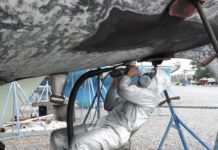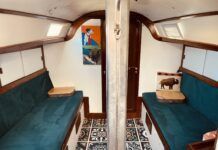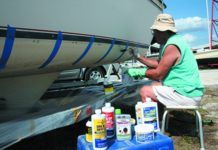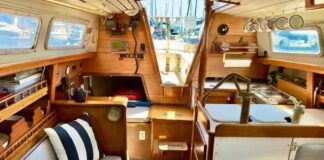Leaky Portlights
Have you ever evaluated how to fix leaking plastic opening portlights from PYHI or Gray or Beckson et al?
Probably need to just replace but I believe that Bomar bought PYHI and they are no longer made. So, how do I get the data about whose stainless steel port will fit the existing cutout for the PYHI ports in the 5″ x 12″ and 7″ x 14″ sizes? Can you help?
-Jim Nicholson
Via e-mail
Youre right, PYHI portlights are no longer available directly from Bomar (603/826-5791), but there are still options. For specs on particular portlights you could start at the following web addresses:
www.beckson.com/ports.html
www.pompanette.com
In the latter case, click on the links for Bomar/Gray.
As for leaks, it depends on where water is coming through. If through the gasket, you may be able to replace the rubber. Gaskets do compress over time, forcing you to tighten the dogs more. With plastic frames, however, this can cause cracks, so its better to simply replace the gaskets than risk breaking the entire assembly. When we talked to Bomar customer service recently we were told that they still carry replacement gaskets for PYHI portlights, so perhaps thats an option for you.
If the leak is occurring around the frame, then the portlight must be removed and all surfaces cleaned. Recaulk, and make sure that all gaps in the cabinside around the portlight are filled. Clean up excess.
If you must replace the portlights with new ones of a different size, you have a bit of a job on your hands. Ideally, youll be able to find ports slightly larger than your existing ones. Then it would a fairly simple job to make larger cutouts with a saber saw. If you have to go smaller in one dimension then youll have to fill the old cutout with fiberglass feathered into the surrounding area and then cut new cutouts. Wed avoid that if at all possible because youll have a hard time matching gelcoat color, not to mention achieving a smooth interior and exterior surface. At that point, wed consider a custom fabricated stainless steel frame and lens.
Mildew on Mylar Sails
I am in the market for new sails for my Tartan 31. I am a club racer and would like to purchase a performance-type sail. I have talked to several sailmakers and they are recommending a Mylar sail. One sailmaker mentioned the fact that these sails will trap moisture when inside a furled headsail and thus cause mildew. They say mildew will not damage the sail itself, but can look pretty bad. Is this a problem of Mylar sails in general, or is this possibly a problem that this sailmaker has experienced with his particular sails?
This sailmakers solution to the problem was to remove the sail from the furler after each use, fold and store. I do not want to have to do this.
None of the other sailmakers I have contacted have mentioned this problem. Are there any resources available where I can find information about this problem and possibly solutions to it as well?
-Tom Willer
Kansas City, Missouri
It does seem that laminate sailcloth is somewhat more prone to mildew than woven cloth, no matter who makes the cloth.
Youre right – removing the sail from the furler every time you use it will be a pain in the neck. It undermines the convenience of having a roller furler in the first place. Unfortunately, racing sails have always needed some coddling, and theres still an extra price to pay for the improved performance of Mylar.
Maybe theres a compromise solution: First, don’t leave your sail furled for long periods of time, especially in humid weather, or if youre planning to leave it for a week or more at a time.
Second, when you do take it off the furler, wipe it all down with diluted bleach or Lysol, and let it dry completely.
Third, if you decide to take the plunge for Mylar, confirm with the sailmaker that the sail will be built with a fungicide in the glue/bonding agent when the sail is built.







































